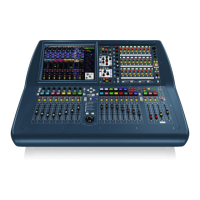Glossary 554
PRO2 Live Audio System
Owner’s Manual
Bay: One of the five main control centre
modules, which contains a control surface and a
GUI screen.
Bus: A pathway down which one or more signals
can travel.
C
Cat 5e: A specification for a type of cable used
typically for Ethernet computer networks.
Channel: Single path taken by an audio signal
(input or output) through the control centre.
Channel strip: Row of controls in traditional
analogue layout used for the shaping of a signal.
Checkpoint: A patching data store point,
created by clicking CHECKPOINT. See
Patching.
Click: A method of GUI operation, mainly for
button operation and selection purposes.
CMR: Abbreviation for “common mode
rejection”. A measure of how well a differential
amplifier rejects a signal that appears
simultaneously and in-phase at both input
terminals. CMR is usually stated as a dB ratio at
a given frequency.
Comb filtering: Removal of signal components
at a number of regularly spaced frequencies.
Compressor: A dynamics processor that
reduces the level of any signal exceeding a
specified threshold volume.
Condenser microphone: A high quality mic
that uses a capacitor to detect changes in the
ambient air pressure, which it then converts into
an electrical signal. This type of mic requires
power from a battery or external source.
Control centre: The console of the PRO2,
comprising control surface and GUI.
Control surface: Area on the control centre
that houses all of the user’s hardware controls,
such as pushbuttons, control knobs, switches
etc.
Crossfade: To combine signals such that one
channel or source fades out while another fades
in, but maintaining an essentially constant
programme volume. Also known as “X-fade” or
“xfade”.
Cursor: Generally, used to describe the
“I”-shaped pointer on the GUI that indicates a
text insertion point. See Pointer.
D
D zone: Section in the input channel strip for
controlling dynamic parameters.
D/A: Abbreviation for “digital to analogue”. The
conversion of digital data to analogue audio.
DARS: Abbreviation for “digital audio reference
signal”.
Dashboard: A standard GUI screen display -
usually on the output bay - that shows all
channel meters (inputs, auxes, returns, masters
etc.) all of the time.
dB: Symbol for “decibel”. A unit of
measurement of the loudness of sound. See
dBu.
dBu: A unit of measurement of sound used in
professional audio. Derived from the decibel,
where the “u” stands for unloaded, this unit is
an RMS measurement of voltage based on
0.775V
RMS
, which is the voltage at which you
get 1mV of power in a 600 ohm resistor. This
used to be the standard impedance in most
professional audio circuits.
DC: Abbreviation for “direct current”.
Delay: An effect by which a reproduction of a
signal is played back later then its original.
Destination: In patching, the patch connector
to which a signal is routed. See Patching.
Detail area: a control section in the channel
strips.
Device: A diagram(s) on the I/O tabs (GUI
patching) representing a physical rack unit, such
as a line I/O, mic splitter, DN9696, AES50 etc.
See Patching.
DHCP: Abbreviation for “dynamic host
configuration protocol”. A network configuration
protocol for IP network hosts.
DI: Abbreviation for “direct inject” or “direct
injection”. Signal is plugged directly into the
audio chain without using a microphone.
DI box: Device for matching the signal level
impedance of a source to mixer input.
Divergence: The spreading of sound waves
from a source in a free field environment, that
is, one with no reflections. Causes the sound
pressure levels in the far field of the source to
decrease as the distance from it increases.
Drag: A method of GUI operation, mainly for
control adjustment. Also used for selecting
blocks of patch connectors during patching.
DSP: Abbreviation for “digital signal processing”
or “digital signal processor”. Any signal

